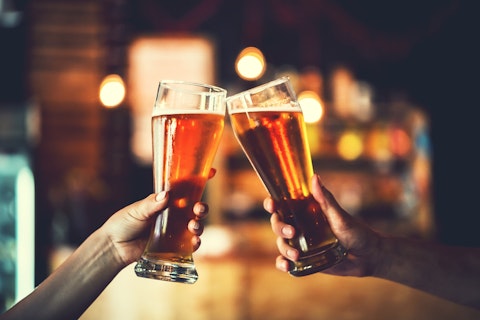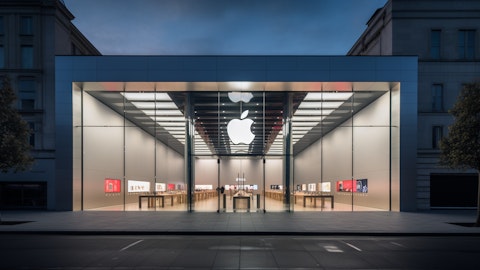In this article, we are going to discuss the 15 countries with the highest alcohol consumption in Europe. You can skip our detailed analysis of the global alcohol industry, the effect of taxes on alcohol abuse, and the rising popularity of non-alcoholic beer in Europe, and go directly to 5 Countries with the Highest Alcohol Consumption in Europe.
Europe has a particular wealth of different drinking cultures, with so many countries so close together, all of which enjoy drinking traditions that can differ vastly. However, the fact that it is the tipsy continent can essentially be traced back to climatic circumstances which forced European ancestors to rely on fermented beverages to store calories and have access to safe drinking water.
In the Middle Ages and early modern times, water was very often polluted, full of microbes, and basically unfit to drink, thus forcing everyone – from commoners to royalty – to hydrate by way of beer or wine. Wine is naturally free of dangerous bacteria thanks to fermentation and its acidic content, and was often diluted with water before consumption. Beer, besides being sterile due to boiling, also had a high nutritional value, especially for populations which based their diet on cereals. As a result, simply by way of necessity, alcohol became an important part of the European diet for men, women, and children alike.
The Global Alcohol Industry:
In 2019, the global alcohol consumption, measured in liters of pure alcohol per person of 15 years of age or older, was 5.5 liters, which is a 4.7% decrease from 5.7 liters in 2010. As we mentioned in our article – 30 Drunkest Countries in the World – the global alcoholic beverages market was valued at $1.62 trillion in 2021, and is projected to reach $2 trillion by 2031, with a CAGR of 2.2% during the forecast period.
The market is likely to be driven by the increasing global young-adult demographic, coupled with high disposable income and consumer demand for premium/super-premium products. Globally, beer drives the market for alcoholic beverages. Regionally, North America and Asia-Pacific are expected to dominate the market during the forecast period.
According to the 2021 European Health Report by the WHO, Europe is the continent that drinks the most alcohol in the world, with every person aged 15 and over consuming an average of 9.5 liters of pure alcohol every year. This is equivalent to around 190 liters of beer, 80 liters of wine, or 24 liters of spirits.
The Effect of Taxes on Alcohol Abuse:
The booze industry argues that alcohol excise taxes do not reduce heavy drinking because of substitutions to lower-cost products and that these taxes disproportionately burden low-income drinkers. Alternatively, over the last two decades, a growing number of economists have examined the impact of alcohol beverage taxes and prices on alcohol consumption and heavy drinking. Several of these studies have focused on high-risk populations, such as youth and young adults, including college students.
This research, using a variety of different data and empirical approaches, has generally found that an increase in the prices of alcoholic beverages led to reductions in drinking, heavy drinking, and the consequences of alcohol use and abuse. These findings indicate that a rise in alcoholic-beverage taxes could be a highly effective option for reducing alcohol abuse and its consequences.
According to a study conducted by the NCD Advisory Council’s signature initiative working group, if countries of the WHO European Region were to introduce a minimum level of 15% tax on the retail price per unit of alcohol, regardless of the type of alcoholic beverage, it would save 133,000 lives each year.
The Rising Popularity of Non-Alcoholic Beer:
There is currently an increasing demand for low- and no- alcohol beverages in the European Union as consumers are looking for more options, taste, and also lifestyle changes. This is especially the case for beer which is already a well-established market in most of the E.U. member states. In 2020, Europe was the world’s top producer of non-alcoholic beer, with a major share of 45.2% in the global market.
This trend has attracted the attention of several key players around the globe and one industry giant leading the charge is Anheuser-Busch InBev SA/NV (NYSE:BUD). The beer behemoth has set the ambitious goal of ensuring that low- or no-alcohol beer products make up at least 20% of its global beer volume by 2025. As a result, the company announced this summer that it is investing $34.4 million in upgrading some of its Belgian breweries, which will help expand its non-alcoholic beer portfolio.
The investment will also improve Anheuser-Busch InBev SA/NV (NYSE:BUD)’s bottling capabilities and optimize a new de-alcoholizing system that is used to make Corona Cero – the company’s newest non-alcoholic version of its classic Mexican lager that debuted in ten European countries last year.
Anheuser-Busch InBev SA/NV (NYSE:BUD) ranks among the Largest Alcohol Companies in the World in 2023.
Similarly, Guinness-owner Diageo plc (NYSE:DEO) has also recently invested $26.7 million in a new facility at St. James’s Gate in Dublin for its non-alcoholic stout. The new Guinness 0.0 production facility has a total capacity of 500,000 hectolitres, and is a big expansion of production capacity since the non-alcoholic stout launched in the Irish market in mid 2021. The investment is spurred by increasing demand from consumers for the 0.0 option, as Diageo plc (NYSE:DEO) forecasts that the non-alcoholic alternative will account for 10% of all Guinness trademark sales in Ireland in the coming years.
Diageo plc (NYSE:DEO) sits among the Best Alcohol Stocks to Own According to Hedge Funds.
With that said, here are the Drunkest Countries in Europe.

Ievgenii Meyer/Shutterstock.com
Methodology:
To collect information for this article, we have referred to The Global Health Observatory of the World Health Organization, looking for Countries that Consume the Most Alcohol in Europe. The following countries have been ranked by their per capita consumption of pure alcohol for people aged 15 and over in 2019.
One thing to keep in mind is that just because the people in these countries generally consume higher levels of alcohol, it doesn’t necessarily mean that they’re drunkards. Alcohol is simply an essential part of many cultures around the world and alcoholic beverages play a significant role in important events and celebrations, since they can be associated with many festivals and rituals.
If you’re also interested to read about which cities consume the most alcohol in the U.S., here are the Drunkest Cities in America in 2023.
15. Andorra
Alcohol Consumption per Capita: 11.05 liters
Andorra has one of the lowest tax rates on food and alcohol. The tax on food is just 1%, while the alcohol tax is 4.5%. In neighboring Spain, most taxes start from 20%, and that’s why many people come from France and Spain to Andorra just to stock their fridges by buying fish, meat, groceries, and alcohol.
14. Estonia
Alcohol Consumption per Capita: 11.26 liters
Prices of goods and services increased rapidly in Estonia last year while the rise in alcohol prices was significantly less. The prices of beer and grape wine rose slightly but the price of hard alcohol remained at the 2021 level or cheaper. The incomes of the Estonian people continued to grow in 2022 and so alcohol became even more accessible.
With 12.2% of its population suffering from alcohol use disorder, Estonia sits among the Most Alcoholic Countries in Europe in 2023.
13. France
Alcohol Consumption per Capita: 11.3 liters
Recognized all over the world for its savoir-faire regarding food and drink, France has a long history of alcohol production and consumption. Wine is deeply embedded in the French culture and identity of the people. There are vineyards scattered throughout the country, responsible for producing 7-8 billion bottles of wine a year.
With an average wine consumption of 6.44 liters per capita, France sits among the Top Wine Drinking Countries in the World.
12. Moldova
Alcohol Consumption per Capita: 11.36 liters
The wine culture is very strong in the Republic of Moldova and the wine industry employs almost 10% of the national workforce, with the income generated from viticulture forming 15% of the annual national budget. Up to 70% of alcohol consumed in the country is homemade wine.
Moldova ranks among the Top Alcohol Drinking European Countries.
11. Luxembourg
Alcohol Consumption per Capita: 11.53 liters
Since alcohol is relatively cheaper in Luxembourg, a large number of Belgians travel regularly to their neighboring country to buy their favorite tipples. The country is also famous for its high quality wine, about two-thirds of which is consumed domestically.
10. Poland
Alcohol Consumption per Capita: 11.63 liters
Vodka is deeply embedded in Polish culture, so much so that there is even a growing debate between Russian and Polish people as to who invented the popular spirit. Poland is the largest market for vodka in the E.U., representing over 35% sales in the region. With over 20% of the vodka market share in the country, the Żubrówka brand remains the market leader.
Poland is counted among the Top 10 Countries that Drink the Most Alcohol in Europe.
9. Ireland
Alcohol Consumption per Capita: 11.7 liters
Ireland is a nation with a love for alcohol and the Irish prefer to spend their time in pubs rather than casual cafes and restaurants. The country produces some of the finest stouts or whiskeys than anywhere else in the world. In fact, the Emerald Isle is home to Guinness – one of the Most Consumed Beer Brands in the World.
8. Lithuania
Alcohol Consumption per Capita: 11.79 liters
Lithuanians mostly prefer to drink beer, which makes 44% of the total consumed alcohol in the country, while wine accounts for 15%. In order to discourage people from consuming alcohol, the Lithuanian government has enacted a number of legal and administrative changes over the last decade. For example, in 2014 it became illegal to consume alcohol in public places, like streets and parks.
7. Bulgaria
Alcohol Consumption per Capita: 11.92 liters
Bulgaria has one of the highest levels of alcohol consumption, roughly equivalent to 2.6 bottles of wine or 4.9 liters of beer per week per person aged 15 or older. Based on the current consumption patterns in the country, OECD simulations estimate that diseases and injuries caused by drinking lead to treatment costs equivalent to 1.8% of the national health expenditure.
6. Austria
Alcohol Consumption per Capita: 11.97 liters
Austria has not only developed a culture for food, but also a drinking culture that is second to none. Although each region has its own preference, beer and wine are the most popular alcoholic drinks in the country.
Unlike in some European countries, purchasing alcohol in Austria is regulated at a regional level. Essentially, there are two different age requirements – either 16 or 18 years – and these depend on the region and the percentage of alcohol content.
Austria is among the European Countries that Drink the Most Alcohol in 2023.
Click to continue reading and see the 5 Countries with the Highest Alcohol Consumption in Europe.
Suggested Articles:
- 20 Countries with Highest Rates of Alcoholism
- 15 African Countries with the Most Alcohol Consumption
- 20 Most Consumed Alcohols in the World
Disclosure: None. 15 Countries with the Highest Alcohol Consumption in Europe is originally published on Insider Monkey.





